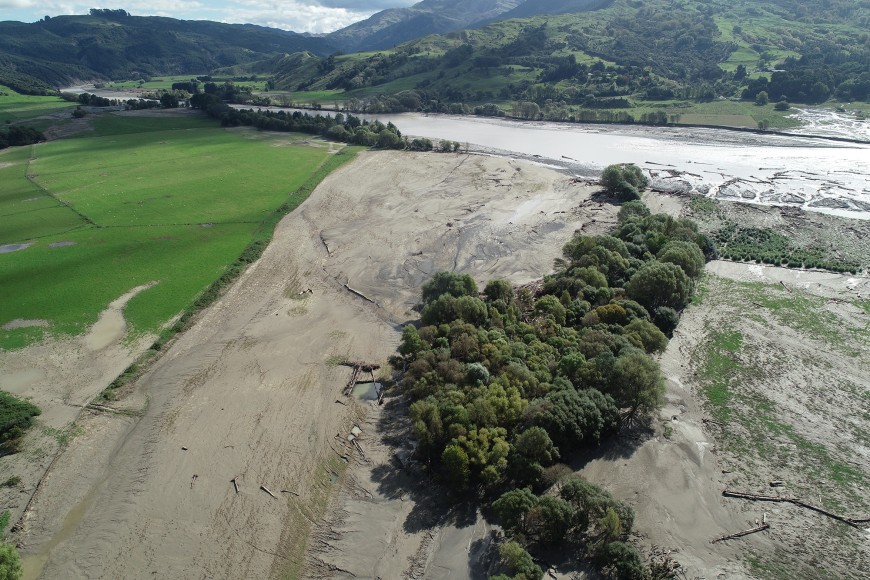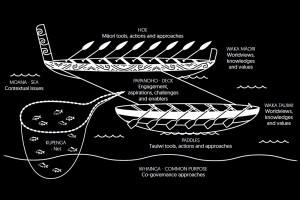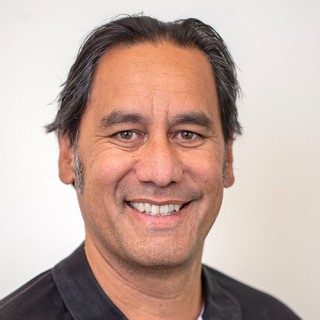Noho tahanga a Papatūānuku kia whakakororwai i ai ia
Papatūānuku [The earth mother] lays bare; we must recloak her
– Keita Ngata (Ngāti Porou)

The image above was taken by Manaaki Whenua’s Andrew McMillan. We would like to thank Manu Caddie, the Waingakia Station and whānau who supported Andrew to take images following the devastation caused by Cyclone Gabrielle on the East Coast.
In the wake of the devastation caused by Cyclone Gabrielle and the increasing impact of climate change, there is a call to ensure a Māori world view is incorporated into risk assessment frameworks and decision-making processes.
Led by Manaaki Whenua Kaihautū Māori Research Impact Leader Dr Shaun Awatere, the impact of extreme weather events and climate change on Māori communities is being investigated by a team of researchers focused on a te ao Māori (Māori world view) perspective.
Shaun says during this period of recovery there is a need to ensure Māori are part of the process when it comes to making decisions on replanting, rebuilding, and economic choices concerning their communities.
“There is a need to rebalance the system and ensure Māori are at the decision-making table. For example, they will have views on what should be replanted and where, as well as the importance of certain culturally significant sites that have been lost or damaged. They know and understand their whenua [land].”
Cyclone Gabrielle highlighted the vulnerability of Māori communities on the East Coast of the North Island, as many marae and urupā (cemeteries) are located in coastal, low-lying areas that are prone to flooding and sea-level rise.
“It is mana whenua who understand their whenua and must be consulted and involved in the rebuild in order to ensure the whenua is recloaked for future generations,” says Shaun.
The whakataukī (proverb) above, which was gifted to researchers, highlights that the earth mother lays bare, as she has been stripped and disrespected, in part caused by unsustainable forestry practices, leaving her vulnerable to landslides and erosion.
Shaun has developed a kaupapa Māori disaster risk reduction framework, which gives mana (value) back to the environment and demonstrates that we are obligated to treat the environment with respect.
“The Māori view is more holistic, relational, and cyclical, emphasising the need for balance. The cosmic forces of mana and mauri provide a powerful yet relatively simple way of understanding risk and vulnerability,” he says.
A reduction in risk is achieved through mātauranga (Māori knowledge), whakapapa (connectivity), kaupapa (key issues), community, and tikanga (principles and practices), which provide the knowledge, connections, ethics, scale, and behaviours for reduction.
“Likewise, the framework highlights that resilience can be enhanced through strengthening community, care, capital goods, culture, and control, empowering communities to take the lead on reinforcing their capacity to withstand hazards.”
Shaun and his colleagues have also developed the framework He Waka Taurua, which conceptualises a decision-making framework through a te ao Māori lens, with the symbolic waka intended to serve as a Maōri cultural memory retention device.
He Waka Taurua explicitly identifies a te ao Maōri world view and associated values as a distinct and complete knowledge system, separate from a Western science world view. This is represented by the two hulls, waka Māori and waka Tauiwi, and the hoe (paddles), which represent the tools, actions, and approaches relevant to each world view.
These world views are kept separate from each other, while the papanoho (deck) between the canoes represents a shared or ‘negotiated space’, where engagement and innovation can occur.
As the recovery and rebuild phase following Cyclone Gabrielle continues, it is hoped these frameworks can be used to empower Māori and create sustainable whenua and local economies.

